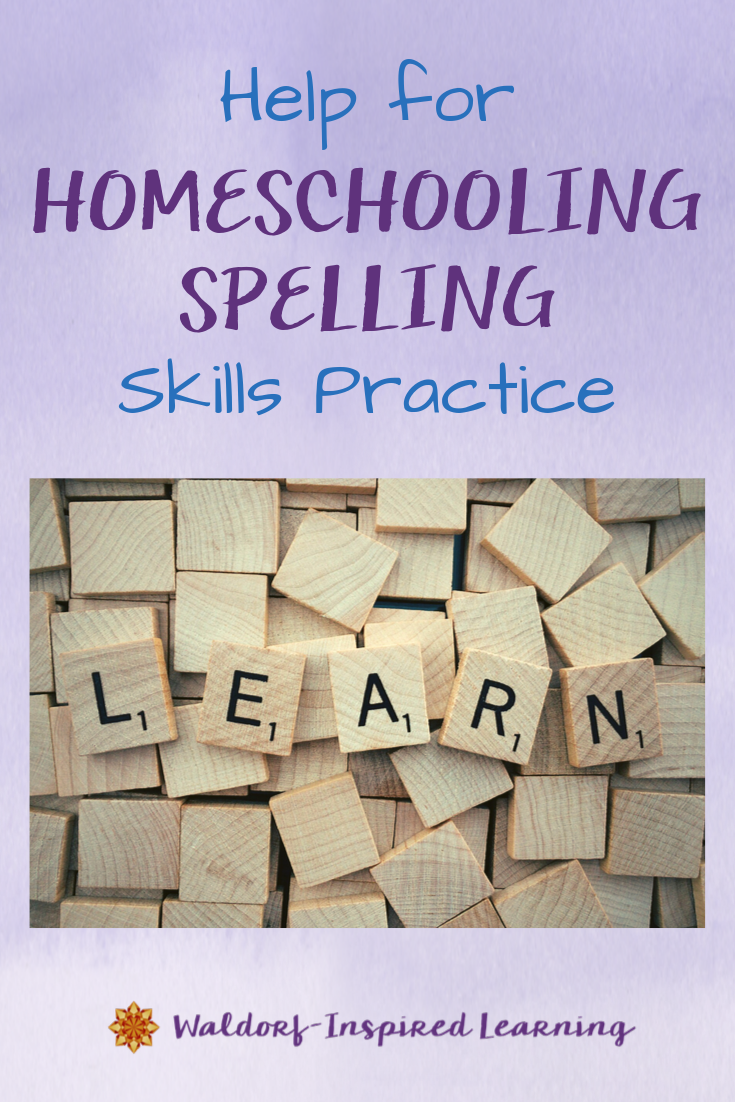Do you have painful memories of spelling lessons as a child? I know I felt like those weekly lists of spelling words were pointless. You may have even found them dreadful. And now it’s time to bring spelling to your children. Where do you begin? Today, I offer you some help for homeschooling spelling skills practice along with how to weave spelling practice into your main lessons.
First, like any other subject in Waldorf homeschooling, we want to make spelling a lively experience. And a lot of this is built right into the Waldorf approach!
We have our children recite verses, learn them by heart, and feel into the rhythm of the sounds. Sometimes, we even add movements and this helps children learn the sounds and words with their whole being.
We can take those verses and ask our children to write them into their main lesson books or a special copy work book. We might even point out “this is the way grownups write these words.”
Then our children read back what they have written, and then spell out the words letter-by-letter. This way, the words are related to an experience the child has had. They become friends as part of this lively experience.
Some children need extra help with spelling. Even after main lesson book work, even after reciting and copying verses, some children have a difficult time with spelling and need extra skills practice in this area.
The most important thing to remember is to continue to keep this practice related to the child’s writing and reading.
Why study spelling? It can help foster a child’s healthy relationship to authority, as well as listening and observation skills.
If you need some guidance and are looking for a resource to help you bring your children this homeschooling spelling skills practice, here are three resources that might help.

This post contains some affiliate links for your convenience. You can read my full disclosure policy here.
Help for Homeschooling Spelling Skills Practice
My first recommendation is a book that is a great companion for first and second grades. I sure wish this book had been around when my children were in those grades! This is a great companion to the introduction of letter stories in first grade and the expansion into word families in second.
Word Mastery Primer for First and Second Graders compiled by Hugh Renwick is a simple and very usable guide. Here’s a great description of learning in these early years from the introduction: “The point is to stimulate the child’s imagination, pictorial thinking, and sense of sound which are natural at this age, and which make learning much more accessible and engaging.”
This primer offers a phonetic approach to help children read and spell by sounding out words so that they gain skills and confidence. You’ll find both long and short vowel sounds and combinations as well as consonant blends to help children develop both writing and reading skills.
Use this book with your language arts main lesson blocks and/or for additional skills practice.
My second recommendation is another practical book by Jeremy Hermann called Spelling by Hand: Teaching Spelling in a Waldorf School, a Guide for Class Teachers.
Spelling by Hand emphasizes the importance of short daily practice when it comes to spelling. But this can be done in five to fifteen minutes each day.
This concise book offers a summary of a spelling curriculum for grades 1-6. Hermann illustrates a technique for hand spelling and finger spelling that adds a physical component to the sounds. He starts with regular words in grades one and two, and moves to irregular words by grades five and six. You could definitely start using this book in any of these grades.
The book includes 36 simple spelling games plus spelling word lists. The activities in this book would make a great addition to language arts lessons at home. They could also lend themselves to mixed-ages activities depending on your children’s skill levels.
My final recommendation is a book that is popular among homeschoolers but is not specific to the Waldorf approach. This one has an even broader age span for grades 1-8. Natural Speller by Kathryn Stout also includes basic word lists for each grade grouped by similar patterns. For the older grades, there are also words grouped by Latin and Greek roots.
You can easily pick and choose from these lists, giving your children words they need to work on and skipping ones they don’t!
In conclusion, remember that our job as homeschooling parents is to observe our children and bring them what they need! Some children are natural spellers on their own and may not need a lot of extra practice. Others will benefit from spelling practice during main lessons as well as skills practice sessions during say a math block after main lesson work if finished.
The beauty is that as homeschoolers, we get to decide what our children need most. And if you’re looking for help for homeschooling spelling skills practice, one of these books could be just the thing.
You might also be interested in these posts:
- 3 Helpful Resources for Homeschooling English Language Arts
- Developing Literacy in the Early Elementary Grades (the first in a series of 4 interviews with one of the authors of The Roadmap to Literacy)


